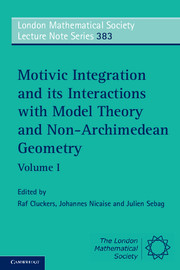Book contents
- Frontmatter
- Contents
- List of contributors
- 1 Introduction
- 2 Introductory notes on the model theory of valued fields
- 3 On the definition of rigid analytic spaces
- 4 Topological rings in rigid geometry
- 5 The Grothendieck ring of varieties
- 6 A short course on geometric motivic integration
- 7 Motivic invariants of rigid varieties, and applications to complex singularities
- 8 Motivic integration in mixed characteristic with bounded ramification: a summary
- References
5 - The Grothendieck ring of varieties
Published online by Cambridge University Press: 07 October 2011
- Frontmatter
- Contents
- List of contributors
- 1 Introduction
- 2 Introductory notes on the model theory of valued fields
- 3 On the definition of rigid analytic spaces
- 4 Topological rings in rigid geometry
- 5 The Grothendieck ring of varieties
- 6 A short course on geometric motivic integration
- 7 Motivic invariants of rigid varieties, and applications to complex singularities
- 8 Motivic integration in mixed characteristic with bounded ramification: a summary
- References
Summary
Introduction
Since its creation in the middle of the nineties, the theory of motivic integration has been developed in different directions, following a geometric and/or model-theoretic approach. The theory has profound applications in several areas of mathematics, such as algebraic geometry, singularity theory, number theory and representation theory.
A common feature of the different versions of motivic integration is that the integrals take their values in an appropriate Grothendieck ring, often the Grothendieck ring of varieties. Many applications of motivic integration involve equalities of certain motivic integrals, and hence equalities in the Grothendieck ring of varieties; see, for example, the Batyrev-Kontsevich Theorem [6], which motivated the introduction of motivic integration. Therefore, it is natural to ask for the geometric meaning behind such equalities in the Grothendieck ring.
Unfortunately, the Grothendieck ring of varieties is quite hard to grasp, and little is known about it; many basic and fundamental questions remain unanswered. The central question is arguably the one raised by Larsen and Lunts (see Section 6.2), for which only partial results have been obtained so far.
The present paper is a survey on the Grothendieck ring of varieties. We recall its definition (Section 3), and its main realization maps (Section 4). These realizations constitute the motivic nature of the Grothendieck ring. Besides, we motivate the study of the Grothendieck ring by listing the principal known results, and formulating some challenging open problems (Section 5), which are connected to fundamental questions in algebraic geometry.
- Type
- Chapter
- Information
- Motivic Integration and its Interactions with Model Theory and Non-Archimedean Geometry , pp. 145 - 188Publisher: Cambridge University PressPrint publication year: 2011
References
- 16
- Cited by

